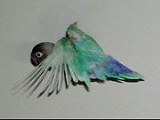
Fischer's Lovebird
Encyclopedia
The Fischer's Lovebird (Agapornis fischeri) is a small parrot
species of the Agapornis
genus. They were originally discovered in the late 19th century, and were first bred in the United States in 1926. They are named after German explorer Gustav Fischer
.
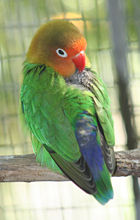 The Fischer's Lovebird has a green back, chest, and wings. Their necks are a golden yellow and as it progresses upward it becomes darker orange. The top of the head is olive green, and the beak is bright red. The upper surface of the tail has some purple or blue feathers. It has a white circle of bare skin (eyering) around its eyes. Young birds are very similar to the adults, except for the fact that they are duller and the base of their mandible
The Fischer's Lovebird has a green back, chest, and wings. Their necks are a golden yellow and as it progresses upward it becomes darker orange. The top of the head is olive green, and the beak is bright red. The upper surface of the tail has some purple or blue feathers. It has a white circle of bare skin (eyering) around its eyes. Young birds are very similar to the adults, except for the fact that they are duller and the base of their mandible
has brown markings. They are one of the smaller lovebirds, about 14 cm (5.5 in) in length and 43-58g weight.
While most Fischer's Lovebirds are green, several color variations have been bred. The blue variation is predominant; lacking yellow, it has a bright blue back, tail, and chest, a white neck, a pale grey head and a pale pink beak. This mutation was first bred by R. Horsham in South Africa
in 1957, and two years later it was bred by Dr. F. Warford in San Francisco, California
. There is a yellow mutation, which first appeared in France
. These birds are typically pale yellow with an orange face and a red beak. Lutino (a mutation that is yellow in color), pied, black or dark eyed white, cinnamon, white, and albino mutations have also been bred.
The sexes of Agapornis fischeri appear the same, and are distinguished with certainty through DNA testing, and less certainly by their habits in perching. Generally, females sit with their legs farther apart than males.
, south and southeast of Lake Victoria
in northern Tanzania
. In drought
years, some birds move west into Rwanda
and Burundi
seeking moister conditions. They live at elevations of 1,100-2,200m in small flocks. They live in isolated clumps of trees with grass plains between them. The population is estimated to be between 290,000-1,000,000, with low densities outside of protected areas due to capture for the pet trade; export licenses were suspended in 1992 to halt any further decline in the species.
. They sometimes are pests to farmers, as they eat their crops such as maize
and millet
.
is in a hole in a tree 2 to 15 metres above the ground. The eggs are white and there are usually four or five in a clutch, but there could be as few as three or as many as eight. The female incubates the eggs for 23 days, and the chicks fledge
from the nest about 38–42 days after hatching.
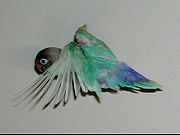 Fischer's lovebirds are kept in captivity. Lovebirds are social animals.
Fischer's lovebirds are kept in captivity. Lovebirds are social animals.
(a minimum of 20 x 20 x 30 inches / 50 x 50 x 75 cm for one bird, 25 x 25 x 30 inches / 65 x 65 x 75 cm for a pair.) Round cages do not properly give a lovebird a corner to hide in when they feel insecure. They also require lots of toys and things to chew on and play with. Without enough toys (4-6) and things to play with they may get bored, depressed and may even go as far as feather-plucking
, which can be difficult to stop. It is also a good idea to provide a bird bath tub, as they love to take baths almost every day. After bathing they like to sun themselves in order to dry off. However, they should not be near any windows, or they may become sick.
s and avian nutritionists, rather than the millet food that is usually sold in pet stores, as this is claimed to contain too much fat and lack nutritional balance.
An opposing view is that a seed-based diet, supplemented by the aforementioned green foods is sufficient to maintain health and vitality, however an all-seed diet may lead to health problems, including fatty liver disease
. Some pellets may contain artificial coloring or the preservatives ethoxyquin and BHT
/BAT, which are considered toxic.
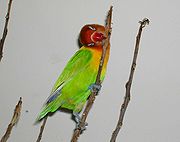
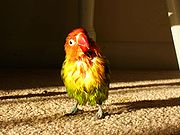 Each lovebird has their own individual personality, but some generalizations can be made. At first they are very timid and will get spooked by sudden movements, loud noises, or new things, even small ones. One should be very careful not to scare them too much, which can interfere with their taming. Lovebirds are very smart and may even figure out how to open the door of their cage and get out.
Each lovebird has their own individual personality, but some generalizations can be made. At first they are very timid and will get spooked by sudden movements, loud noises, or new things, even small ones. One should be very careful not to scare them too much, which can interfere with their taming. Lovebirds are very smart and may even figure out how to open the door of their cage and get out.
Many owners believe the female birds, which are slightly larger, are more intelligent than the males. They are also generally more aggressive, and more likely to be territorial.
Adding to their intelligence, once they are tame and comfortable, they are very curious. If they are allowed outside their cage, one should take great care to safeguard the house by not letting them fly around the kitchen with the stove on, around any wires, around places where they could get stuck, such as behind the refrigerator, etc. A house can be a very dangerous place for lovebirds; additionally lovebirds can be rough on a house. They are avid chewers, have strong beaks and can quickly cause damage.
They also like to be clean, often preening their feathers and regularly taking baths. If let outside their cage, they may even fly to other places in order to defecate. Newspaper should be placed below their favorite areas for easy cleanup.
Fischer's lovebirds when tame make engaging pets. They are lively, curious and playful, and when out of their cage constantly explore their environment. While they are not cuddly, and do not like to be touched, they can become affectionate and quite attached to humans. They can enjoy perching on their owners, "preening" their hair and clothing, and chewing on clothing, buttons, watches, and jewellery. They are nippy, and will bite fingers and hands, sometimes aggressively, though more often simply for the pleasure of chewing something new.
If kept in cages it is vital that they are provided new toys on a regular basis, and frequent opportunities to explore outside of their cages, and to stretch their wings. Because of their intelligence they are liable to boredom and depression if not interacted with regularly.
_in_flight.jpg) Buying and fed Fischer's lovebirds can be quite expensive, but if one wants pets to interact with, it is recommended. Because they are very timid at first, great patience is required to tame non hand fed lovebirds. With females they are much easier to tame as the males can be very timid and stubborn. Taming them enough to climb onto one's finger (which they don't like very much) or to get them to fly on a shoulder (which they prefer) can take years.
Buying and fed Fischer's lovebirds can be quite expensive, but if one wants pets to interact with, it is recommended. Because they are very timid at first, great patience is required to tame non hand fed lovebirds. With females they are much easier to tame as the males can be very timid and stubborn. Taming them enough to climb onto one's finger (which they don't like very much) or to get them to fly on a shoulder (which they prefer) can take years.
Lovebirds (in general) are not known for their talking ability, although there are some lovebirds that do learn words - the females are usually the ones that do this. As is the case when many smaller parrots, the "voice" of lovebirds is high-pitched and raspy and it may be difficult to understand their speech.
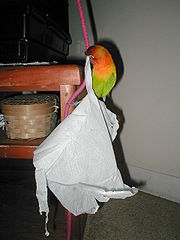 Lovebirds are very vocal birds, making loud, high-pitched noises that can be a nuisance. They make noise all day, but especially at certain times of day. That said, Fischer's are not quite as loud as some other lovebird varieties, and while they cheep frequently, they do not scream like the larger parrots. Their noise level increases substantially when they are engaged in pre-mating rituals.
Lovebirds are very vocal birds, making loud, high-pitched noises that can be a nuisance. They make noise all day, but especially at certain times of day. That said, Fischer's are not quite as loud as some other lovebird varieties, and while they cheep frequently, they do not scream like the larger parrots. Their noise level increases substantially when they are engaged in pre-mating rituals.
As stated above, lovebirds are also extremely active, and love to chew things. It is wise to observe the birds carefully when let out of their cage, and to protect any furniture, or anything they have access to.
Fischer's Lovebirds, like many captive birds, can suffer from feather-plucking if they get bored or stressed. This is more likely to occur with single lovebirds than those kept in pairs or groups. They should have a roomy cage, and should be shown affection if they enjoy it. After feather-plucking starts, it is very hard to stop the habit. Providing them with plenty of toys and giving them more opportunities for entertainment will often reduce or stop the habit.
Lovebirds are notorious for attempting to build nests, especially during mating season - for this reason, loose material such as shredded paper and fabric do not make suitable toys at certain times of year, as the lovebirds could see it as nest-making material and attempt to mate. Breeding is not something that should be attempted by someone without lots of experience. "Huts" or hiding places and small enclosures are also not good for the same reason.
Fischer's Lovebirds are prone to a mysterious disease characterized by having brownish to creamish patches in their feet and legs, which is probably an infection
as a result of their obsessive biting of those areas. It is not known what causes this disease. One hypothesis is that they suffer from hormonal problems caused by changing light levels and the inability to perform things Fischer's lovebirds in the wild would naturally perform, such as building a nest. Another hypothesis is that it is caused by a pathogen
. If the signs are detected, fischer's lovebirds should immediately be taken to the vet. Treatments usually involve antibiotic
s for the wounds, and some way to stop them from continuing the biting of the area. This can sometimes be accomplished with sedative
s. Use of the Elizabeth collar should be an option of last resort, as wearing them is extremely stressful both to the bird wearing the collar and to the birds around it. Some lovebirds may start feather-plucking as a result of the stress.
Female lovebirds are prone to egg-binding, an often fatal condition in which an egg cannot be laid as it gets caught in the reproductive tract. It is thought that egg binding often occurs due to a lack of liquid calcium in the diet, which causes a softer shell. To prevent this, females, particularly those kept in pairs, should be given calcium supplementation in their water from a young age. Additionally, egg binding appears more likely amongst younger birds; to avoid egg binding females in captivity should be prevented from engaging in mating behaviours until at least one year of age.
True parrots
The true parrots are about 330 species of bird belonging to the Psittacidae family, one of the two "traditional" families in the biological order Psittaciformes . The other family is the Cacatuidae which are also parrots, but not classified as true parrots...
species of the Agapornis
Lovebird
A Lovebird is one of nine species of the genus Agapornis . They are a social and affectionate small parrot. Eight species are native to the African continent, while the Grey-headed Lovebird is native to Madagascar...
genus. They were originally discovered in the late 19th century, and were first bred in the United States in 1926. They are named after German explorer Gustav Fischer
Gustav Fischer
Gustav Adolf Fischer was a German African explorer.-Biography:He was born at Barmen. In 1876 he accompanied the Denhardt East Africa exploring expedition to Zanzibar, where he settled as a physician, and in the following year explored Wituland and the southern Oromo country...
.
Description

Mandible
The mandible pronunciation or inferior maxillary bone forms the lower jaw and holds the lower teeth in place...
has brown markings. They are one of the smaller lovebirds, about 14 cm (5.5 in) in length and 43-58g weight.
While most Fischer's Lovebirds are green, several color variations have been bred. The blue variation is predominant; lacking yellow, it has a bright blue back, tail, and chest, a white neck, a pale grey head and a pale pink beak. This mutation was first bred by R. Horsham in South Africa
South Africa
The Republic of South Africa is a country in southern Africa. Located at the southern tip of Africa, it is divided into nine provinces, with of coastline on the Atlantic and Indian oceans...
in 1957, and two years later it was bred by Dr. F. Warford in San Francisco, California
California
California is a state located on the West Coast of the United States. It is by far the most populous U.S. state, and the third-largest by land area...
. There is a yellow mutation, which first appeared in France
France
The French Republic , The French Republic , The French Republic , (commonly known as France , is a unitary semi-presidential republic in Western Europe with several overseas territories and islands located on other continents and in the Indian, Pacific, and Atlantic oceans. Metropolitan France...
. These birds are typically pale yellow with an orange face and a red beak. Lutino (a mutation that is yellow in color), pied, black or dark eyed white, cinnamon, white, and albino mutations have also been bred.
Sexual morphism
Fischer's Lovebirds show no sexual dimorphism, and it is impossible to tell whether an individual is male or female through plumage alone.The sexes of Agapornis fischeri appear the same, and are distinguished with certainty through DNA testing, and less certainly by their habits in perching. Generally, females sit with their legs farther apart than males.
Distribution and habitat
Fischer's Lovebird are native to a small area of east-central AfricaAfrica
Africa is the world's second largest and second most populous continent, after Asia. At about 30.2 million km² including adjacent islands, it covers 6% of the Earth's total surface area and 20.4% of the total land area...
, south and southeast of Lake Victoria
Lake Victoria
Lake Victoria is one of the African Great Lakes. The lake was named for Queen Victoria of the United Kingdom, by John Hanning Speke, the first European to discover this lake....
in northern Tanzania
Tanzania
The United Republic of Tanzania is a country in East Africa bordered by Kenya and Uganda to the north, Rwanda, Burundi, and the Democratic Republic of the Congo to the west, and Zambia, Malawi, and Mozambique to the south. The country's eastern borders lie on the Indian Ocean.Tanzania is a state...
. In drought
Drought
A drought is an extended period of months or years when a region notes a deficiency in its water supply. Generally, this occurs when a region receives consistently below average precipitation. It can have a substantial impact on the ecosystem and agriculture of the affected region...
years, some birds move west into Rwanda
Rwanda
Rwanda or , officially the Republic of Rwanda , is a country in central and eastern Africa with a population of approximately 11.4 million . Rwanda is located a few degrees south of the Equator, and is bordered by Uganda, Tanzania, Burundi and the Democratic Republic of the Congo...
and Burundi
Burundi
Burundi , officially the Republic of Burundi , is a landlocked country in the Great Lakes region of Eastern Africa bordered by Rwanda to the north, Tanzania to the east and south, and the Democratic Republic of the Congo to the west. Its capital is Bujumbura...
seeking moister conditions. They live at elevations of 1,100-2,200m in small flocks. They live in isolated clumps of trees with grass plains between them. The population is estimated to be between 290,000-1,000,000, with low densities outside of protected areas due to capture for the pet trade; export licenses were suspended in 1992 to halt any further decline in the species.
Behaviour
Fischer's Lovebird has a fast, straight flight, and the sound of their wings as they fly can be heard. Like all Lovebirds, they are very vocal and when they do make noise they have a high-pitched chirp and can be very noisy.Food and feeding
Fischer's Lovebirds eat a wide variety of foods, including seeds and fruitFruit
In broad terms, a fruit is a structure of a plant that contains its seeds.The term has different meanings dependent on context. In non-technical usage, such as food preparation, fruit normally means the fleshy seed-associated structures of certain plants that are sweet and edible in the raw state,...
. They sometimes are pests to farmers, as they eat their crops such as maize
Maize
Maize known in many English-speaking countries as corn or mielie/mealie, is a grain domesticated by indigenous peoples in Mesoamerica in prehistoric times. The leafy stalk produces ears which contain seeds called kernels. Though technically a grain, maize kernels are used in cooking as a vegetable...
and millet
Millet
The millets are a group of small-seeded species of cereal crops or grains, widely grown around the world for food and fodder. They do not form a taxonomic group, but rather a functional or agronomic one. Their essential similarities are that they are small-seeded grasses grown in difficult...
.
Breeding
The breeding season is January through April and June through July. The nestNest
A nest is a place of refuge to hold an animal's eggs or provide a place to live or raise offspring. They are usually made of some organic material such as twigs, grass, and leaves; or may simply be a depression in the ground, or a hole in a tree, rock or building...
is in a hole in a tree 2 to 15 metres above the ground. The eggs are white and there are usually four or five in a clutch, but there could be as few as three or as many as eight. The female incubates the eggs for 23 days, and the chicks fledge
Fledge
Fledge is the stage in a young bird's life when the feathers and wing muscles are sufficiently developed for flight. It also describes the act of a chick's parents raising it to a fully grown state...
from the nest about 38–42 days after hatching.
Aviculture

Housing
Fischer's Lovebirds are very active and require a roomy cageBirdcage
A birdcage is a cage designed to house birds as pets.Antique birdcages are often popular as collectors' items or as household decor but most are not suitable for housing live birds, being too small, or of unsafe materials or construction...
(a minimum of 20 x 20 x 30 inches / 50 x 50 x 75 cm for one bird, 25 x 25 x 30 inches / 65 x 65 x 75 cm for a pair.) Round cages do not properly give a lovebird a corner to hide in when they feel insecure. They also require lots of toys and things to chew on and play with. Without enough toys (4-6) and things to play with they may get bored, depressed and may even go as far as feather-plucking
Feather-plucking
Feather-plucking, sometimes termed feather-picking, feather damaging behaviour or pterotillomania, is a maladaptive, behavioural disorder commonly seen in captive birds which chew, bite or pluck their own feathers with their beak, resulting in damage to the feathers and occasionally the skin...
, which can be difficult to stop. It is also a good idea to provide a bird bath tub, as they love to take baths almost every day. After bathing they like to sun themselves in order to dry off. However, they should not be near any windows, or they may become sick.
Food
Fischer's Lovebirds in captivity require a varied diet, including pellets, fruits, seeds, grains, sprouts, and vegetables. Pellets specifically processed for lovebirds are recommended by some avian veterinarianAvian veterinarian
An avian veterinarian is a veterinarian who specializes in treating birds. Birds are very different in anatomy and physiology to dogs and cats, so avian veterinary students must seek out coursework and residencies that are beyond the scope of a standard veterinary school.Avian veterinarians can...
s and avian nutritionists, rather than the millet food that is usually sold in pet stores, as this is claimed to contain too much fat and lack nutritional balance.
An opposing view is that a seed-based diet, supplemented by the aforementioned green foods is sufficient to maintain health and vitality, however an all-seed diet may lead to health problems, including fatty liver disease
Fatty liver
Fatty liver, also known as fatty liver disease , is a reversible condition where large vacuoles of triglyceride fat accumulate in liver cells via the process of steatosis...
. Some pellets may contain artificial coloring or the preservatives ethoxyquin and BHT
Butylated hydroxytoluene
Butylated hydroxytoluene , also known as butylhydroxytoluene, is a lipophilic organic compound that is primarily used as an antioxidant food additive as well as an antioxidant additive in cosmetics, pharmaceuticals, jet fuels, rubber, petroleum products, electrical transformer oil, and embalming...
/BAT, which are considered toxic.
Personality


Many owners believe the female birds, which are slightly larger, are more intelligent than the males. They are also generally more aggressive, and more likely to be territorial.
Adding to their intelligence, once they are tame and comfortable, they are very curious. If they are allowed outside their cage, one should take great care to safeguard the house by not letting them fly around the kitchen with the stove on, around any wires, around places where they could get stuck, such as behind the refrigerator, etc. A house can be a very dangerous place for lovebirds; additionally lovebirds can be rough on a house. They are avid chewers, have strong beaks and can quickly cause damage.
They also like to be clean, often preening their feathers and regularly taking baths. If let outside their cage, they may even fly to other places in order to defecate. Newspaper should be placed below their favorite areas for easy cleanup.
Fischer's lovebirds when tame make engaging pets. They are lively, curious and playful, and when out of their cage constantly explore their environment. While they are not cuddly, and do not like to be touched, they can become affectionate and quite attached to humans. They can enjoy perching on their owners, "preening" their hair and clothing, and chewing on clothing, buttons, watches, and jewellery. They are nippy, and will bite fingers and hands, sometimes aggressively, though more often simply for the pleasure of chewing something new.
If kept in cages it is vital that they are provided new toys on a regular basis, and frequent opportunities to explore outside of their cages, and to stretch their wings. Because of their intelligence they are liable to boredom and depression if not interacted with regularly.
Taming
_in_flight.jpg)
Lovebirds (in general) are not known for their talking ability, although there are some lovebirds that do learn words - the females are usually the ones that do this. As is the case when many smaller parrots, the "voice" of lovebirds is high-pitched and raspy and it may be difficult to understand their speech.
Potential problems

As stated above, lovebirds are also extremely active, and love to chew things. It is wise to observe the birds carefully when let out of their cage, and to protect any furniture, or anything they have access to.
Fischer's Lovebirds, like many captive birds, can suffer from feather-plucking if they get bored or stressed. This is more likely to occur with single lovebirds than those kept in pairs or groups. They should have a roomy cage, and should be shown affection if they enjoy it. After feather-plucking starts, it is very hard to stop the habit. Providing them with plenty of toys and giving them more opportunities for entertainment will often reduce or stop the habit.
Lovebirds are notorious for attempting to build nests, especially during mating season - for this reason, loose material such as shredded paper and fabric do not make suitable toys at certain times of year, as the lovebirds could see it as nest-making material and attempt to mate. Breeding is not something that should be attempted by someone without lots of experience. "Huts" or hiding places and small enclosures are also not good for the same reason.
Fischer's Lovebirds are prone to a mysterious disease characterized by having brownish to creamish patches in their feet and legs, which is probably an infection
Infection
An infection is the colonization of a host organism by parasite species. Infecting parasites seek to use the host's resources to reproduce, often resulting in disease...
as a result of their obsessive biting of those areas. It is not known what causes this disease. One hypothesis is that they suffer from hormonal problems caused by changing light levels and the inability to perform things Fischer's lovebirds in the wild would naturally perform, such as building a nest. Another hypothesis is that it is caused by a pathogen
Pathogen
A pathogen gignomai "I give birth to") or infectious agent — colloquially, a germ — is a microbe or microorganism such as a virus, bacterium, prion, or fungus that causes disease in its animal or plant host...
. If the signs are detected, fischer's lovebirds should immediately be taken to the vet. Treatments usually involve antibiotic
Antibiotic
An antibacterial is a compound or substance that kills or slows down the growth of bacteria.The term is often used synonymously with the term antibiotic; today, however, with increased knowledge of the causative agents of various infectious diseases, antibiotic has come to denote a broader range of...
s for the wounds, and some way to stop them from continuing the biting of the area. This can sometimes be accomplished with sedative
Sedative
A sedative or tranquilizer is a substance that induces sedation by reducing irritability or excitement....
s. Use of the Elizabeth collar should be an option of last resort, as wearing them is extremely stressful both to the bird wearing the collar and to the birds around it. Some lovebirds may start feather-plucking as a result of the stress.
Female lovebirds are prone to egg-binding, an often fatal condition in which an egg cannot be laid as it gets caught in the reproductive tract. It is thought that egg binding often occurs due to a lack of liquid calcium in the diet, which causes a softer shell. To prevent this, females, particularly those kept in pairs, should be given calcium supplementation in their water from a young age. Additionally, egg binding appears more likely amongst younger birds; to avoid egg binding females in captivity should be prevented from engaging in mating behaviours until at least one year of age.

